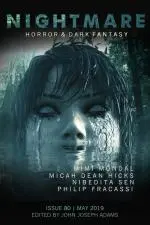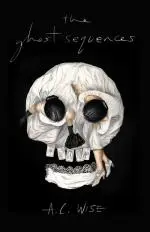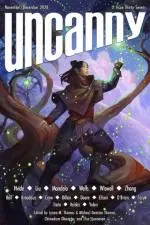Short stories are such an incredible form of creativity; they present writers with the challenge to hook readers in immediately, keep them invested, and complete an arc all within a few thousand words. I’m particularly fond of stories that play with experimental forms, and since horror and speculative fiction focus so much on building dread, pushing boundaries, and leading readers into the unknown, it’s the perfect arena to try out unconventional formats. It can be a rewarding experience as a reader, and also a moment of inspiration and learning as a writer.
I’ve gathered a few stories below that I think are strong examples of what unconventional structures can accomplish. I’d love to know your favorite experimental short pieces, as well! And if you’re a writer, I hope checking out these works and the authors who aren’t afraid to tell powerful tales through unusual formats inspires you to get a little weird with your own structures, viewpoints, and ideas.
![]() “Sister Glitter Blood” by Gwendolyn Kiste
“Sister Glitter Blood” by Gwendolyn Kiste
Gwendolyn Kiste is an inventive storyteller; I had trouble choosing which one of her stories to feature on this list because she has several tales with interesting formats! I decided to highlight “Sister Glitter Blood” because along with that stunning title, the story begins with board game instructions and utilizes second person point of view in a smart way. The reader is taken on a journey through the object of the game, the equipment needed, the rules, and more. Kiste blends exposition cleverly into the game rules in a way that reaches out to the reader and pulls them into both game and story. We feel as if we’re breaking the rules of the game along with the twin sister protagonists, and the overall format and setup of the story contribute to its strength as a beautifully haunting piece of fiction.
Get Violent Vixens at Amazon
![]() “Ten Excerpts from an Annotated Bibliography on the Cannibal Women of Ratnabar Island” by Nibedita Sen
“Ten Excerpts from an Annotated Bibliography on the Cannibal Women of Ratnabar Island” by Nibedita Sen
As the title mentions, “Ten Excerpts” is portrayed through an annotated bibliography, and Nibedita Sen poignantly uses every word to illustrate the experience of how the lives and stories of conquered people become grossly contorted or rewritten altogether by the colonizers. It’s a gutting tale, and Sen’s gorgeous, visceral prose had me stopping several times just to appreciate memorable lines like, “We are all cannibals at birth, and our mother-tongue is the language of the mouth.” The annotated bibliography format is a powerful way to call out how this issue arises in academia, and it also reflects the way versions of a story can be told, yet they are still interpretations—puzzle pieces that may have been dropped in water before someone tried to mush them all back together and then tell their own version of the event. There’s a lot to think about in this story, and I highly recommend reading Nightmare’s spotlight interview with Sen where she goes into more depth about the story and her writing.
Read “Ten Excerpts” on Nightmare’s website
![]() “How to Host a Haunted House Murder Mystery Party” by A.C. Wise
“How to Host a Haunted House Murder Mystery Party” by A.C. Wise
A.C. Wise’s short story collection, The Ghost Sequences, is as gorgeous inside as that striking cover is on the outside. I wanted to feature the above story because Wise takes something like a “How To” format and uses it in such a memorable way. “How to Host a Haunted House Murder Mystery Party” lets readers know all the needed steps from choosing the setting, making the invitations, introducing the guests, and more. It covers the important elements of solid cocktail and entertainment choices, and as the story highlights the needs of a murder mystery party, readers are treated to lines in those instructions that let us know something off is happening here. It’s a fantastic method to build up the dread and suspense in an unconventional way. The story reads like an exciting game of Clue, and Wise contorts the prose into something laced with exquisite melancholy.
Get The Ghost Sequences at Bookshop or Amazon
![]() “A Haunted House is a Wheel Upon Which Some Are Broken” by Paul Tremblay
“A Haunted House is a Wheel Upon Which Some Are Broken” by Paul Tremblay
Okay, one more haunted house story, and it’s a really good one. Paul Tremblay’s story follows Fiona as she returns to a place she once called home—a place haunted by memories, and maybe something else. Each room presents Fiona with recollections of her past and pain, and what makes this story format unique is the way it’s framed similarly to a “choose your own adventure” tale. We end up making the choices for Fiona as she journeys from kitchen to bedroom to dreaded basement, and more; the clever setup creates a strong pacing that makes us feel like we’re moving through each of those rooms with Fiona. We dust off the torment with her, and we have some choice as to what room we visit next, if we skip a room, or if we flee the house and come back later. The format reminded me of grief itself, of how sometimes we must navigate through our haunted pain at our own pace, sometimes not looking back or forward at all until we’re ready. Tremblay writes grief exceptionally well; his work so often tugs at my heartstrings, and even in a short story, he shows his mastery of that ability.
Get Growing Things at Bookshop or Amazon
![]() “50 Things Every AI Working with Humans Should Know” by Ken Liu
“50 Things Every AI Working with Humans Should Know” by Ken Liu
I don’t know about you, but I haven’t read many stories that begin with an obituary and then end with a list. Ken Liu’s science fiction story takes the well-loved idea of a creator and a creation, and ruminates on the potential held between Dr. Tran and her AI, an “experimental generative neural network.” We don’t begin at the creation though, we begin at the end as the AI known as WHEEP-3 is retired, and its obituary is then generated by another AI. Through that obituary, we learn of the whirlwind relationship between woman and machine. There’s a kind of sorrow throughout Liu’s piece that resonates deeply with current times. After reading his interview with Uncanny where he talks about this story’s origin during the early days of the pandemic, it made the work all the more impactful. The addition of the list after the obituary, which is where the title of the story comes from, captures the wonderful weirdness of humanity through the viewpoint of a near-sentient machine. The juxtaposition of everything in the story, including the experiment with the format, makes for a wonderfully unique reading experience.
Read “50 Things” on Uncanny’s website

About the author
Sara Tantlinger is the author of the Bram Stoker Award-winning The Devil’s Dreamland: Poetry Inspired by H.H. Holmes. Along with being a mentor for the HWA Mentorship Program, she is also a co-organizer for the HWA Pittsburgh Chapter. She embraces all things macabre and can be found lurking in graveyards or on Instagram @inkychaotics.
 “Sister Glitter Blood” by Gwendolyn Kiste
“Sister Glitter Blood” by Gwendolyn Kiste
 “Ten Excerpts from an Annotated Bibliography on the Cannibal Women of Ratnabar Island” by Nibedita Sen
“Ten Excerpts from an Annotated Bibliography on the Cannibal Women of Ratnabar Island” by Nibedita Sen
 “How to Host a Haunted House Murder Mystery Party” by A.C. Wise
“How to Host a Haunted House Murder Mystery Party” by A.C. Wise
 “A Haunted House is a Wheel Upon Which Some Are Broken” by Paul Tremblay
“A Haunted House is a Wheel Upon Which Some Are Broken” by Paul Tremblay
 “50 Things Every AI Working with Humans Should Know” by Ken Liu
“50 Things Every AI Working with Humans Should Know” by Ken Liu







